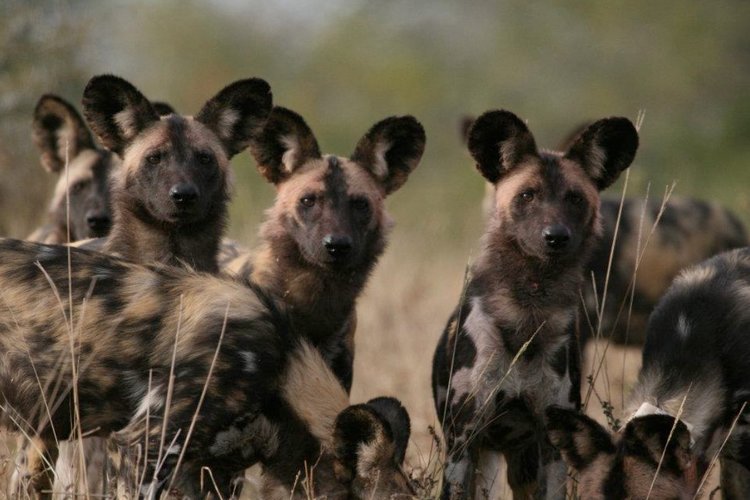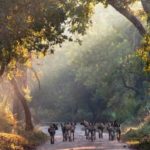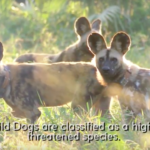

Mozambique, Africa – With only around 6,600 Wild Dogs left in Africa, this iconic species is one of the Continent’s most at-risk carnivores, and is listed by the IUCN as ‘Endangered’. Urgent action is needed to save them. A key conservation strategy is to reintroduce Wild Dogs to viable ecosystems where they once ranged. The Endangered Wildlife Trust (EWT), a champion of wildlife conservation in Africa, and Gorongosa National Park are excited to announce the completion of a historic translocation of Wild Dogs from South Africa to Mozambique.
On April 16, 2018, in a bold and innovative move to reverse the fate of Wild Dogs in southern Africa, this new and exciting partnership between the EWT and Gorongosa National Park ensured the reintroduction of the Park’s first pack of Wild Dogs in decades. This is a landmark occasion, as Wild Dogs have not been reintroduced to any park, protected area, game reserve or other space in the history of Mozambique. This truly represents conservation in action – an ambitious venture to restore Wild Dogs to an incredible ecosystem.
Wild Dogs have disappeared from much of their former range in Mozambique, and Gorongosa lost their population during the 1977-1992 Civil War. Today, Gorongosa is Mozambique’s flagship natural area – the heart of a region where the Government of Mozambique has teamed with the Carr Foundation on a long-term, 25-year restoration project to rehabilitate a vast and diverse natural ecosystem. In just over a decade, many species in the park have made a strong comeback, including tens of thousands of herbivores. The natural next step is the return of large carnivores.






Wild Dogs from South Africa’s EWT-managed metapopulation were used as founder individuals in this reintroduction. The metapopulation, a group of managed national parks and reserves, is the largest population of Wild Dogs in South Africa, numbering 250 individuals in 28 packs (more than that of the Kruger National Park). This population has increased dramatically over the last 20 years and has ensured the increase in Wild Dog range in South Africa by 25% and numbers by 100%.
Males from uMkhuze Game Reserve in KwaZulu-Natal (KZN) that dispersed from their pack in late 2016 and free-roaming KZN females were earmarked for reintroduction. The EWT, along with local partners Ezemvelo KZN Wildlife (EKZNW), the KZN state veterinary department, WildlifeACT, Maremani Game Reserve, LEDET, and the Bateleurs, caught the two unrelated groups of Wild Dogs and brought them together to bond in a boma at Phongola Nature Reserve in KZN in South Africa. The pack was fitted with GPS collars and VHF collars to allow for close monitoring once released. All individuals were vaccinated against canine distemper and rabies, as infectious diseases are a big threat to Wild Dogs.
The new pack was moved from the Phongola boma to Gorongosa by air transfer. The trip from Phongola to Gorongosa is a two-day drive through long, hot and difficult roads, making air transport with the Bateleurs the safer option, thanks to a combination of safe drugs administered by a qualified veterinarian from EKZNW. The sedated pack was under the experienced guard of both the vet and the EWT’s Wild Dog Metapopulation Coordinator. Upon arrival, the sleeping males and females were bonded together in a novel way, called the olfactory acclimatisation technique. The bonded pack is being held in the newly constructed boma in Gorongosa for six to eight weeks before being released. This is to allow the males and females to become accustomed to one another and get habituated to the local area. During this time, Gorongosa’s Carnivore Conservation Team will monitor the health and status of the pack in the boma before release. The EWT will work closely with the Gorongosa team to train a new generation of Mozambican vets and ecologists in Wild Dog recovery and management.
Gorongosa National Park has been described as one of the most diverse parks on Earth, covering a vast expanse of 400,000 hectares. In recent years, the Gorongosa Project, with the support of Mozambique’s National Administration of Conservation Areas (ANAC), has ensured the protection of a recovering population of Lions in this system, successfully reduced key threats, and seen the Park recognised as one of National Geographic’s ‘Last Wild Places.’ It is therefore truly thrilling to take this first, big step on a momentous journey to restore Wild Dogs to this part of their native range.
This work is made possible by EWT funders, Richard Bosman and Land Rover Centurion, Gorongosa Project funders, Gorongosa National Park, Oak Foundation, and ZooBoise.
Gorongosa National Park is home to the E.O. Wilson Biodiversity Laboratory. The center’s main goals are to document Gorongosa’s vast biological richness, manage its restoration, and train a new cadre of local conservationists, educators, and scientists.

